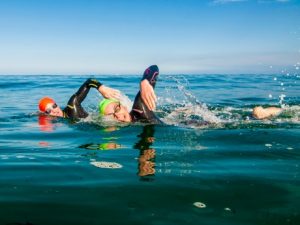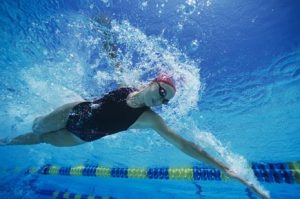Hannah Diaz is a professional soccer player, currently with the Houston Dash. Hannah’s expertise expands to sports nutrition, general fitness, and running. She has coached soccer and conditioning sessions for athletes at many levels. She is a regular contributing writer for Complete Tri.
Whether you are trying to get into swimming for the first time, or go from “good to great” for your triathlon swimming, working on your swim is a key part of your training plan.
Getting your triathlon swim stroke back after a winter of easy pool swims, or creating a good swim stroke if you are new to the sport requires some effort and planning. Many swimmers get comfortable in the pool, and then get into a rut of doing the same workout time after time. Doing so will maintain a certain level of ability, but will not be enough to help you break through the plateaus that set in if you don’t vary your workouts.
For a triathlete, varying workouts is about more than just mixing up workout intensity — it includes getting enough open water time in so you have an advantage in the big water too. In a recent conversation with a group of high-level swimmers, the following tips emerged as advice that novices and experts alike can use to revitalize their training.
Study Swimming
 It might sound simple, but so many people jump in the pool without any type of plan or knowledge. Most advanced swimmers have a idea of what they want to do before they get into the pool, and their technique improvement plan will force them to work on things that will help advance their overall ability. If you are at a loss for how to learn the art of open water swimming, consider a book with practical guidance and a variety of training plans to use. We like the Total Immersion approach, which has been used by thousands over swimmers over the years with indisputable results. We also like the idea of working on 1-2 simple things each offseason. As you improve your technique gradually, you will soon be a high-level swimmer by putting it all together.
It might sound simple, but so many people jump in the pool without any type of plan or knowledge. Most advanced swimmers have a idea of what they want to do before they get into the pool, and their technique improvement plan will force them to work on things that will help advance their overall ability. If you are at a loss for how to learn the art of open water swimming, consider a book with practical guidance and a variety of training plans to use. We like the Total Immersion approach, which has been used by thousands over swimmers over the years with indisputable results. We also like the idea of working on 1-2 simple things each offseason. As you improve your technique gradually, you will soon be a high-level swimmer by putting it all together.
Get a Coach
Sometimes the only way to really change, improve, or (if you are a real beginner) learn your swim stroke is to have someone teach you. We have seen many triathletes over the years, and think that investing in a coach can be a great way to accelerate your learning curve. It also allows you to bypass all the bad habits people tend to learn when swimming on their own. You can find a coach at a local fitness club, or through any number of national swim organizations. It doesn’t take much coaching to correction some issues with your technique, and become faster while expending less energy.

Force Variety
Speaking of having a plan, be sure that plan causes you to have a wide range of swim workouts. The best swimmers will rotate between sprints, long distance, and technique work, sometimes all in the same workout or sometimes having a day that just focuses on one area. Without variety, you will experience the proverbial “rut”, something that affects swimmers, cyclists, runners, and any other athlete who fails to mix it up. For novices, injecting some variety may be as simple as converting your 800 meter swim into 400 meters of sprinting surrounded by 200 warm-up and cool-down on each end.
This also means having a plan as you enter the water. You would never lift weights and simple do the same light weight for 20 minutes and then be done. The value of interval training has been proven, so incorporate it into your swim workouts.
Get in the Open Water
Staying in a pool for all of your swims is a bad idea in general, but a big mistake if your races are in open water. Get in the open water do get the feel for the unpredictability of outdoor conditions, learn how to sight, and become comfortable in simulated race conditions. Practicing in the open water is also a great way to become comfortable in your triathlon wetsuit or the other triathlon clothing you plan to wear on race day. There is something about getting in a body of water that has fish and varying depths that just feels different — be sure you get at least a few practices in that are in the open water. Finally, be safe and be sure to swim with a buddy, or at least someone who can easily see you at all times from the shore.
Consider a Masters Group
Most advanced swimmers swim with some sort of masters swim group. These groups are often early-morning groups that provide for a great workout with people of similar skill levels. A good masters group will cause you to pick up tips from other swimmers and coaches, engage in some friendly competition, all while getting a great swim workout in. In most cities, masters groups can be found at local health clubs, swim centers, or through triathlon clubs.
If this was interesting for you but you are really just looking for open water swim information, consider checking out our articles on Open Water Swim Tips. It is based on years of personal experience, and real-life lessons learned from doing dozens of triathlons first-hand.
Track Your Progress
You would never go to a weight room and just randomly lift weights, without knowing how heavy the weights are or the number of reps. And you typically don’t go for a bike workout ride without thinking “I will ride X miles today.” So why would you ever just start swimming without any idea of the workout’s goal?
Have a plan, and track your progress. Some triathlon watches are actually safe to be used in water, so you can track your distance, duration, and even your swim pace and heart rate. If you don’t want to splurge on a watch, at least consider keeping a workout log. It can be an online version, or a simple notebook. For years, I have used a simple, black leather-bound notebook (so I don’t confuse it with others) that I track my daily workouts in. I add any info on speed and distance, how I felt, and anything else going on (e.g. “Had a cold”) so I can look back and see patterns.
Cross Train
“But swimming IS my cross training!” Yes, for many who are highly run or cycle-centric, the swim training actually is your cross-training. However, when you start adding more swim laps, you could stress specific joints through mild overuse, such as the shoulder or the elbow. Upper back issues can be common with swimmers, too. Injecting some bodyweight HIIT workouts into your training plan will help balance and tone your muscles, so the pool workouts don’t overly-stress one particular joint or muscle group. Additionally, you might want to do some lite gym resistance work, but keep it on the easy side. Just like a golfer, a swimmer doesn’t actually want to bulk up too much — it is about functional strength and muscle tone.







